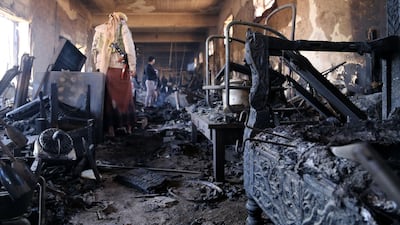Yemen’s Taiz National Museum, destroyed in 2016 after an attack by Houthi rebels, has reopened after a restoration of its exterior and roof.
The restoration was made possible by a £100,000 (Dh482,442) grant from the British Council’s Cultural Protection Fund and a private US donor, awarded to the World Monuments Fund (WMF) Britain in late 2018. Repairs on the building have been conducted by WMF in partnership with the General Organisation of Antiquities and Museums (GOAM) of Taiz, beginning in the spring of 2019 until the end of last year.
Since 2014, a Houthi coup in Sanaa has led to a devastating war between the internationally-recognized government and Houthi rebels. The ongoing conflict has also put the country’s cultural heritage at risk, with museums and historic sites looted and damaged.
When the Taiz National Museum was hit by shelling years ago, a resulting fire ravaged the building and destroyed numerous artefacts, including 1,000-year-old manuscripts and copies of the Quran, as well as a ceremonial turban that belonged to an ancient king.
To deal with restrictions on air travel to Yemen, WMF met with GOAM staff in Kuwait to discuss the restoration of the building. According to The Art Newspaper, the WMF also provided a camera to document their progress and energy alternatives such as solar panels and generators to help keep the operations going amidst electricity failures.
The museum’s interior is still in need of repair, and funding for this endeavour will be provided through a partnership between WMF and the Aliph Foundation, a global fund developed by France and the UAE dedicated to the reconstruction and protection of war-torn heritage sites.
Today, Yemen's archaeological and cultural sites remain vulnerable to targeting and destruction caused by the conflict. Previous coalition-led airstrikes have wreaked damage on places such as the majestic Kawkaban Fortress and the Great Marib Dam, which dates back to the 8th century. Taiz’s 12th-century Cairo Castle and Unesco Heritage Site Shibam have also been attacked.
Looting of museums is also a concern. Yemen's culture minister, Marwan Dammaj, claims that Houthi rebels and terrorist groups like Al Qaeda in the Arabian Peninsula have been known to sell and smuggle objects from cultural sites. Recently, the Yemeni government made a plea to the US and United Nations to help stem the distribution of significant artefacts from the country.
The authorities have requested the US to impose stricter rules for the import of Yemeni artefacts, stating that all objects must possess special documentation. The US has issued emergency orders in the past, specifically for Iraq, Syria and Libya.


